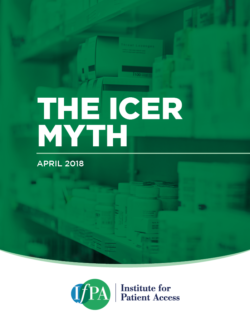The ICER Myth
April 6, 2018
 What stands between patients and the treatment prescribed by their doctors?
What stands between patients and the treatment prescribed by their doctors?
In some cases, the barriers are obvious. High co-pays at the pharmacy counter, for instance, or a health insurer’s prior authorization requirement that leaves patients waiting for treatment.
In other cases, the barriers are harder to grasp. Nowhere is this truer than with the growing prominence of a Boston-based health economics organization known as ICER, or the Institute for Clinical and Economic Review. Amid widespread debate about pharmaceutical prices, ICER has made a name for itself by generating the unicorn of health care economic analysis: the price at which an innovative drug provides value.
The group has come under scrutiny for its methodology and calculations. Critics have also made an issue of ICER’s funding, some of which comes directly from health insurers or from nonprofit foundations supported by health insurers.
But perhaps the organization’s biggest drawback is its suggestion that the value of life-altering drugs for individual patients can be lumped into a “one-size-fits-all” calculation.
ICER’s “value-based price” is a fallacy, and a dangerous one. In the hands of health plans, these prices can become negotiation tools. If drug manufacturers don’t meet health insurers’ demands, coverage policies may put new drugs out of patients’ reach.
This paper explores the drawbacks of ICER’s evidence reports and how those issues affect patients.
Tags: Cost ValueCategorized in: Analysis, Policy Papers, White Papers

